Related Research Articles

The Angora or Ankara is a Turkish breed of domesticated goat. It produces the lustrous fibre known as mohair. It is widespread in many countries of the world. Many breeds derive from it, among them the Indian Mohair, the Soviet Mohair, the Angora-Don of the Russian Federation and the Pygora in the United States.
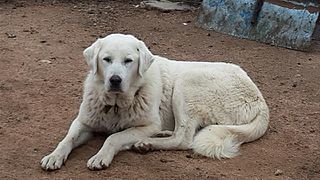
The Akbash is a traditional Turkish breed or type of flock guardian dog from western Anatolia. The word akbaş means 'white head', and thus distinguishes this dog from the Karabaş, or 'black head'. It was recognised by the Turkish Ministry of Agriculture and Rural Affairs in 2006; it is under the tutelage of the Köpek Irkları ve Kinoloji Federasyonu, the Turkish dog breed society, but is not recognised by the Fédération Cynologique Internationale.

A landrace is a domesticated, locally adapted, often traditional variety of a species of animal or plant that has developed over time, through adaptation to its natural and cultural environment of agriculture and pastoralism, and due to isolation from other populations of the species. Landraces are distinct from cultivars and from standard breeds.

The American Pygmy is an American breed of achondroplastic (dwarf) goat. It is small, compact and stockily built. Like the Nigerian Dwarf, it derives from the West African Dwarf group of breeds of West Africa. Between 1930 and 1960, animals of this type were imported to the United States for use either as zoo animals or for research; some were later kept and bred as companion animals and established as a breed in 1975.

The Nigerian Dwarf is a modern American breed of dwarf goat. Like the American Pygmy Goat, it derives from the West African Dwarf group of breeds of West Africa.
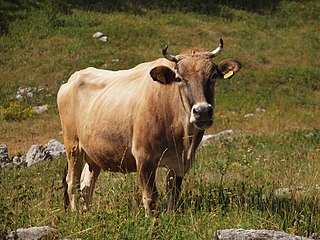
The Buša or Busha is a breed or group of breeds of small short-horned cattle distributed in south-eastern Europe, principally in Albania and the countries of the former Yugoslavia – Bosnia and Herzegovina, Croatia, Kosovo, Macedonia, Montenegro and Serbia. Related breeds include the Gurgucke, Lekbibaj and Prespa of Albania, the Gacko of Bosnia and Herzegovina, the Greek Shorthorn, the Metohija Red of Kosovo and the Rhodope Shorthorn of Bulgaria.

The Kinder is an American breed of domestic goat. It originated on a farm in Snohomish, Washington, where in about 1985 an American Pygmy buck was cross-bred with Nubian does. The resulting stock was selectively bred to create a compact but well-muscled goat, suitable both for milk and for meat production. A herd-book was started in 1988; by 2006 about three thousand head had been registered.

The Livestock Conservancy, formerly known as the American Livestock Breeds Conservancy (ALBC) and prior to that, the American Minor Breeds Conservancy, is a nonprofit organization focused on preserving and promoting rare breeds, also known as "heritage breeds" of livestock. Founded in 1977, through the efforts of livestock breed enthusiasts concerned about the disappearance of many of the US's heritage livestock breeds, The Livestock Conservancy was the pioneer livestock preservation organization in the United States, and remains a leading organization in that field. It has initiated programs that have saved multiple breeds from extinction, and works closely with similar organizations in other countries, including Rare Breeds Canada. With 3,000 members, a staff of eleven and a 19-member board of directors, the organization has an operating budget of over a million dollars.
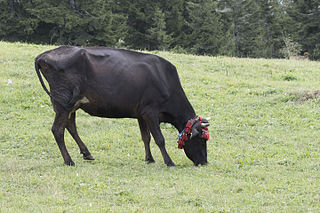
The Anatolian Black, also known as Native Black Cattle, is a breed of cattle that originated in Anatolia, in what is now Turkey. They are used in dairy production, meat production, and as draught animals on small farms. They are primarily raised in central Turkey.
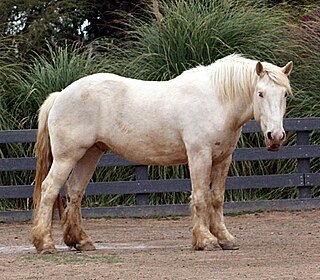
In modern agriculture, a rare breed is a breed of poultry or livestock that has a very small breeding population, usually from a few hundred to a few thousand. Because of their small numbers, rare breeds may have a threatened conservation status, and they may be protected under regional laws. Many countries have organizations devoted to the protection and promotion of rare breeds, for which they each have their own definition. In botany and horticulture, the parallel to rare animal breeds are heirloom plants, which are rare cultivars.

The Irish Goat is a traditional Irish breed of domestic goat. It is a dual-purpose breed, used both for meat and for milk. It is an endangered breed and may survive only in feral populations. It is distinct from the feral Bilberry Goat of Waterford.
The Bursa tumbler is a breed of fancy pigeon originating in Bursa, Turkey. Locally, the people are called “oynar” or “akkanat” – white wings. Bursa pigeons, along with other varieties of domesticated pigeons, are all descendants from the rock pigeon.

The Valdostana is an Italian breed of domestic goat from the autonomous region of Valle d'Aosta in north-western Italy, from which it takes its name. It is characterised by large sabre-shaped horns, which it uses in combat in the traditional local sport of goat-fighting.
The Rize Koyan is a breed of livestock guardian dog from north Black Sea shore in Turkey.

Animal genetic resources for food and agriculture (AnGR), also known as farm animal genetic resources or livestock biodiversity, are genetic resources of avian and mammalian species, which are used for food and agriculture purposes. AnGR is a subset of and a specific element of agricultural biodiversity.

The Pygmy is a British breed of dwarf goat. It is small, compact and generally stockily built. It was established in the 1980s by fusion of the various miniature goat populations of the United Kingdom into a single breed. These were of two principal types: a stocky achondroplastic type derived from the West African Dwarf group of breeds of West Africa; and a small but well-proportioned type derived from the Southern Sudan goat.
The Kars, known as the Kars Köpeği in Turkish, is a breed of livestock guardian dog from eastern Turkey.
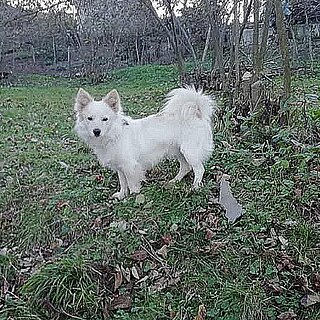
The Tonya Finosu is a white spitz dog indigenous to Trabzon, Turkey, especially the city of Tonya. Tonya Finosu are valued both for their natural suspicion of strangers as well as their playfulness and affection with their family.
The Dikkulak is a small spitz dog native to the Agri, Ardahan, Erzurum, Igdir, and Kars provinces in Turkey, the same areas as the Kangal. It is used as a small guard dog.
References
- ↑ Yilmaz; Kor; Ertugrul; Wilson (2012). "The domestic livestock resources of Turkey: goatbreeds and types and their conservation status". Animal Genetic Resources. 51: 105–116. doi:10.1017/S2078633612000331 . Retrieved October 10, 2015.
- 1 2 Porter, Valerie (2002). Mason's World Dictionary of Livestock Breeds, Types and Varieties. New York: CABI. ISBN 9780851994307.
- 1 2 3 4 Yalçin, B (1986). "Sheep and Goats in Turkey". FAO Corporate Document Repository. Food and Agriculture Organisation. Retrieved October 10, 2015.
- 1 2 Yilmaz; Kor; Ertugrul; Wilson (2012). "The domestic livestock resources of Turkey: goat breeds and types and their conservation status". Animal Genetic Resources. doi:10.1017/S2078633612000331 . Retrieved October 10, 2015.